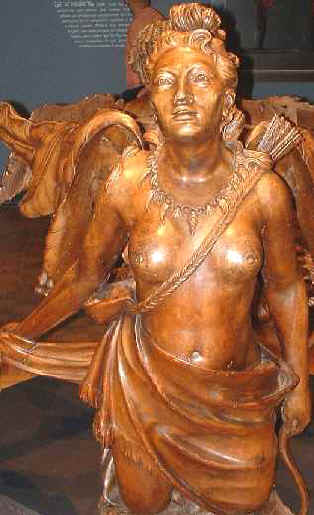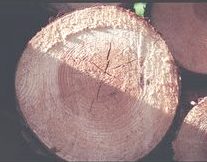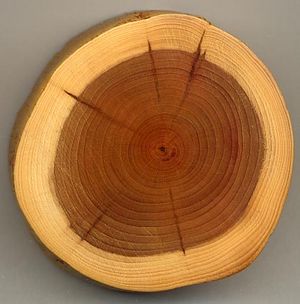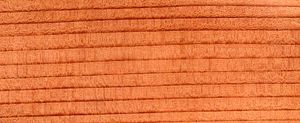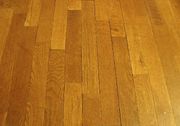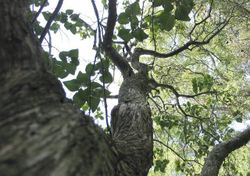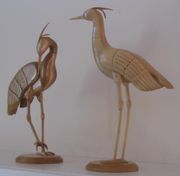|
WOOD
|
||||||||||||||||||||||||||||||||||
|
HOME BIOLOGY GEOGRAPHY HISTORY INDEX MUSIC FILMS THE BOAT SOLAR BOATS SPONSORS |
||||||||||||||||||||||||||||||||||
|
Wood derives from woody plants, notably trees but also shrubs. Wood from the latter is only produced in small sizes, reducing the diversity of uses.
In its most common meaning, "wood" is the secondary xylem of a woody plant, but this an approximation only: in the wider sense, wood may refer to other materials and tissues with comparable properties. Wood is a hygroscopic, cellular and anisotropic material. Dry wood is composed of fibers of cellulose (40%–50%) and hemicellulose (20%–30%) held together by lignin (25%–30%).
Uses
Artists can use wood to create delicate sculptures
Wood has been used for millenia for many purposes, being many things to many people. One of its primary uses is as fuel. It is also used as a material, for making artworks, boats, buildings, furniture, ships, tools, weapons, etc. Wood has been an important construction material since humans began building shelters, and remains in plentiful use today. Construction wood is commonly known as timber in International English, and lumber in American English. Wood may be broken down and be made into chipboard, engineered wood, hardboard, medium-density fibreboard (MDF), oriented strand board (OSB), paper or used to make other synthetic substances.
Formation
A tree increases in diameter by the formation, between the old wood and the inner bark, of new woody layers which envelop the entire stem, living branches, and roots. Where there are clear seasons, this can happen in a discrete pattern, leading to what is known as growth rings, as can be seen on the end of a log. If these seasons are annual these growth rings are annual rings. Where there is no seasonal difference growth rings are likely to be absent.
Within a growth ring it may be possible to see two more or less well-defined parts. The part nearest the centre of the tree is more open textured and almost invariably lighter in color than that near the outer portion of the ring. The inner portion is formed early in the season, when growth is comparatively rapid; it is known as early wood or spring wood. The outer portion is the late wood or summer wood, being produced in the summer. In white pines there is not much contrast in the different parts of the ring, and as a result the wood is very uniform in texture and is easy to work. In hard pines, on the other hand, the late wood is very dense and is deep-colored, presenting a very decided contrast to the soft, straw-colored early wood. In ring-porous woods each season's growth is always well defined, because the large pores of the spring abut on the denser tissue of the fall before. In the diffuse-porous woods, the demarcation between rings is not always so clear and in some cases is almost (if not entirely) invisible to the unaided eye.
Tree trunk as found at the Veluwe, The Netherlands
Knots
Knots are portions of branches included in the wood of the stem or larger branch. Branches generally originate at or near the pith (central axis) of a stem, and the living portion will increase in size through the addition of annual woody layers which are a continuation of those of the stem. The included portion is irregularly conical in shape with the tip at the pith. The fibre direction is at right angles or oblique to the grain of the stem, thus producing local cross grain. Note that a small knot may also be the result of a dormant bud.
During the development of a tree the lower limbs die, but may persist for a time--often for years. Subsequent layers of growth of the stem are no longer intimately joined with the dead limb, but are laid around it. Hence dead branches produce knots which are nothing more than pegs in a hole, and likely to drop out after the tree has been sawn. In grading lumber and structural timber, knots are classified according to their form, size, soundness, and the firmness with which they are held in place.
Knots materially affect checking (cracking) and warping, ease in working, and cleavability of timber. They are defects which weaken timber and depreciate its value for structural purposes where strength is an important consideration. The weakening effect is much more serious where timber is subjected to bending and tension than where under compression. The extent to which knots affect the strength of a beam depends upon their position, size, number, direction of fibre, and condition. A knot on the upper side is compressed, while one on the lower side is subjected to tension. The knot, especially (as is often the case) if there is a season check in it, offers little resistance to this tensile stress. Small knots, however, may be so located in a beam along the neutral plane as actually to increase the strength by tending to prevent longitudinal shearing. Knots in a board or plank are least injurious when they extend through it at right angles to its broadest surface. Knots which occur near the ends of a beam do not weaken it. Sound knots which occur in the central portion one-fourth the height of the beam from either edge are not serious defects.
Knots do not necessarily influence the stiffness of structural timber. Only defects of the most serious character affect the elastic limit of beams. Stiffness and elastic strength are more dependent upon the quality of the wood fibre than upon defects in the beam. The effect of knots is to reduce the difference between the fibre stress at elastic limit and the modulus of rupture of beams. The breaking strength is very susceptible to defects. Sound knots do not weaken wood when subject to compression parallel to the grain.
For some purposes, e.g. wall panelling, knots are considered a plus as they add visual texture to the wood, giving it a more interesting appearance.
Heartwood and sapwood
Examination of the end of a log of many species reveals a darker-colored inner portion, called the heartwood or duramen, surrounded by a lighter-colored zone called the sapwood. In some instances this distinction in color is very marked; in others, the contrast is slight, so that it is not always easy to tell where one leaves off and the other begins. The color of fresh sapwood is always light, sometimes nearly white, but more often with a decided tinge of yellow or brown.
Section of a Yew branch showing 27 annual growth rings, pale sapwood and dark heartwood, and pith (centre dark spot). The dark radial lines are small knots
Sapwood is comparatively new wood, comprising living cells in the growing tree. All wood in a tree is first formed as sapwood. Its principal functions are to conduct water from the roots to the leaves and to store up and give back according to the season the food prepared in the leaves. The more leaves a tree bears and the more vigorous its growth, the larger the volume of sapwood required. Hence trees making rapid growth in the open have thicker sapwood for their size than trees of the same species growing in dense forests. Sometimes trees grown in the open may become of considerable size, 30 cm or more in diameter, before any heartwood begins to form, for example, in second-growth hickory, or open-grown pines.
As a tree increases in age and diameter an inner portion of the sapwood becomes inactive and finally ceases to function, as the cells die. This inert or dead portion is called heartwood. Its name derives solely from its position and not from any vital importance to the tree. This is shown by the fact that a tree can thrive with its heart completely decayed. Some species begin to form heartwood very early in life, so having only a thin layer of live sapwood, while in others the change comes slowly. Thin sapwood is characteristic of such trees as chestnut, black locust, mulberry, osage-orange, and sassafras, while in maple, ash, hickory, hackberry, beech, and pine, thick sapwood is the rule.
There is no definite relation between the annual rings of growth and the amount of sapwood. Within the same species the cross-sectional area of the sapwood is very roughly proportional to the size of the crown of the tree. If the rings are narrow, more of them are required than where they are wide. As the tree gets larger, the sapwood must necessarily become thinner or increase materially in volume. Sapwood is thicker in the upper portion of the trunk of a tree than near the base, because the age and the diameter of the upper sections are less.
When a tree is very young it is covered with limbs almost, if not entirely, to the ground, but as it grows older some or all of them will eventually die and be broken off. Subsequent growth of wood may completely conceal the stubs which will however remain as knots. No matter how smooth and clear a log is on the outside, it is more or less knotty near the middle. Consequently the sapwood of an old tree, and particularly of a forest-grown tree, will be freer from knots than the heartwood. Since in most uses of wood, knots are defects that weaken the timber and interfere with its ease of working and other properties, it follows that sapwood, because of its position in the tree, may have certain advantages over heartwood.
It is remarkable that the inner heartwood of old trees remains as sound as it usually does, since in many cases it is hundreds of years, and in a few instances thousands of years, old. Every broken limb or root, or deep wound from fire, insects, or falling timber, may afford an entrance for decay, which, once started, may penetrate to all parts of the trunk. The larvae of many insects bore into the trees and their tunnels remain indefinitely as sources of weakness. Whatever advantages, however, that sapwood may have in this connection are due solely to its relative age and position.
If a tree grows all its life in the open and the conditions of soil and site remain unchanged, it will make its most rapid growth in youth, and gradually decline. The annual rings of growth are for many years quite wide, but later they become narrower and narrower. Since each succeeding ring is laid down on the outside of the wood previously formed, it follows that unless a tree materially increases its production of wood from year to year, the rings must necessarily become thinner as the trunk gets wider. As a tree reaches maturity its crown becomes more open and the annual wood production is lessened, thereby reducing still more the width of the growth rings. In the case of forest-grown trees so much depends upon the competition of the trees in their struggle for light and nourishment that periods of rapid and slow growth may alternate. Some trees, such as southern oaks, maintain the same width of ring for hundreds of years. Upon the whole, however, as a tree gets larger in diameter the width of the growth rings decreases.
There may be decided differences in the grain of heartwood and sapwood cut from a large tree, particularly one that is mature. In some trees, the wood laid on late in the life of a tree is softer, lighter, weaker, and more even-textured than that produced earlier, but in other species, the reverse applies. In a large log the sapwood, because of the time in the life of the tree when it was grown, may be inferior in hardness, strength, and toughness to equally sound heartwood from the same log. Different woods
There is a strong relationship between the properties of wood and the properties of the particular tree that yielded it. For every trees species there is a range of density for the wood it yields. There is a rough correlation between density of a wood and its strength (mechanical properties). For example, while mahogany is a medium-dense hardwood which is excellent for fine furniture crafting, balsa is light, making it useful for model building. The densest wood may be black ironwood.
Wood is commonly classified as either softwood or hardwood. The wood from conifers (e.g. pine) is called softwood, and the wood from broad-leaved trees (e.g. oak) is called hardwood. These names are a bit misleading, as hardwoods are not necessarily hard, and softwoods are not necessarily soft. The well-known balsa (a hardwood) is actually softer than any commercial softwood. Conversely, some softwoods (e.g. yew) are harder than most hardwoods.
Color
In species which show a distinct difference between heartwood and sapwood the natural color of heartwood is usually darker than that of the sapwood, and very frequently the contrast is conspicuous. This is produced by deposits in the heartwood of various materials resulting from the process of growth, increased possibly by oxidation and other chemical changes, which usually have little or no appreciable effect on the mechanical properties of the wood. Some experiments on very resinous Longleaf Pine specimens, however, indicate an increase in strength. This is due to the resin which increases the strength when dry. Such resin-saturated heartwood is called "fat lighter". Structures built of fat lighter are almost impervious to rot and termites; however they are very flammable. Stumps of old longleaf pines are often dug, split into small pieces and sold as kindling for fires. Stumps thus dug may actually remain a century or more since being cut. Spruce impregnated with crude resin and dried is also greatly increased in strength thereby.
The wood of Coast Redwood is distinctively red in colour
Since the late wood of a growth ring is usually darker in color than the early wood, this fact may be used in judging the density, and therefore the hardness and strength of the material. This is particularly the case with coniferous woods. In ring-porous woods the vessels of the early wood not infrequently appear on a finished surface as darker than the denser late wood, though on cross sections of heartwood the reverse is commonly true. Except in the manner just stated the color of wood is no indication of strength.
Abnormal discoloration of wood often denotes a diseased condition, indicating unsoundness. The black check in western hemlock is the result of insect attacks. The reddish-brown streaks so common in hickory and certain other woods are mostly the result of injury by birds. The discoloration is merely an indication of an injury, and in all probability does not of itself affect the properties of the wood. Certain rot-producing fungi impart to wood characteristic colors which thus become symptomatic of weakness. Ordinary sap-staining is due to fungous growth, but does not necessarily produce a weakening effect.
Structure
In coniferous or softwood species the wood cells are mostly of one kind, tracheids, and as a result the material is much more uniform in structure than that of most hardwoods. There are no vessels ("pores") in coniferous wood such as one sees so prominently in oak and ash, for example.
Wood cut into straight planks and for a hardwood floor (parquet)
The structure of the hardwoods is more complex. They are more or less filled with vessels: in some cases (oak, chestnut, ash) quite large and distinct, in others (buckeye, poplar, willow) too small to be seen plainly without a small hand lens. In discussing such woods it is customary to divide them into two large classes, ring-porous and diffuse-porous. In ring-porous species, such as ash, black locust, catalpa, chestnut, elm, hickory, mulberry, and oak, the larger vessels or pores (as cross sections of vessels are called) are localized in the part of the growth ring formed in spring, thus forming a region of more or less open and porous tissue. The rest of the ring, produced in summer, is made up of smaller vessels and a much greater proportion of wood fibres. These fibres are the elements which give strength and toughness to wood, while the vessels are a source of weakness.
In diffuse-porous woods the pores are scattered throughout the growth ring instead of being collected in a band or row. Examples of this kind of wood are basswood, birch, buckeye, maple, poplar, and willow. Some species, such as walnut and cherry, are on the border between the two classes, forming an intermediate group.
If a heavy piece of pine is compared with a light specimen it will be seen at once that the heavier one contains a larger proportion of late wood than the other, and is therefore considerably darker. The late wood of all species is denser than that formed early in the season, hence the greater the proportion of late wood the greater the density and strength. When examined under a microscope the cells of the late wood are seen to be very thick-walled and with very small cavities, while those formed first in the season have thin walls and large cavities. The strength is in the walls, not the cavities. In choosing a piece of pine where strength or stiffness is the important consideration, the principal thing to observe is the comparative amounts of early and late wood. The width of ring is not nearly so important as the proportion of the late wood in the ring.
It is not only the proportion of late wood, but also its quality, that counts. In specimens that show a very large proportion of late wood it may be noticeably more porous and weigh considerably less than the late wood in pieces that contain but little. One can judge comparative density, and therefore to some extent weight and strength, by visual inspection.
No satisfactory explanation can as yet be given for the real causes underlying the formation of early and late wood. Several factors may be involved. In conifers, at least, rate of growth alone does not determine the proportion of the two portions of the ring, for in some cases the wood of slow growth is very hard and heavy, while in others the opposite is true. The quality of the site where the tree grows undoubtedly affects the character of the wood formed, though it is not possible to formulate a rule governing it. In general, however, it may be said that where strength or ease of working is essential, woods of moderate to slow growth should be chosen. But in choosing a particular specimen it is not the width of ring, but the proportion and character of the late wood which should govern.
The twisty branch of a Lilac tree
In the case of the ring-porous hardwoods there seems to exist a pretty definite relation between the rate of growth of timber and its properties. This may be briefly summed up in the general statement that the more rapid the growth or the wider the rings of growth, the heavier, harder, stronger, and stiffer the wood. This, it must be remembered, applies only to ring-porous woods such as oak, ash, hickory, and others of the same group, and is, of course, subject to some exceptions and limitations.
In ring-porous woods of good growth it is usually the middle portion of the ring in which the thick-walled, strength-giving fibres are most abundant. As the breadth of ring diminishes, this middle portion is reduced so that very slow growth produces comparatively light, porous wood composed of thin-walled vessels and wood parenchyma. In good oak these large vessels of the early wood occupy from 6 to 10 per cent of the volume of the log, while in inferior material they may make up 25 per cent or more. The late wood of good oak, except for radial grayish patches of small pores, is dark colored and firm, and consists of thick-walled fibres which form one-half or more of the wood. In inferior oak, such fibre areas are much reduced both in quantity and quality. Such variation is very largely the result of rate of growth.
Wide-ringed wood is often called "second-growth", because the growth of the young timber in open stands after the old trees have been removed is more rapid than in trees in the forest, and in the manufacture of articles where strength is an important consideration such "second-growth" hardwood material is preferred. This is particularly the case in the choice of hickory for handles and spokes. Here not only strength, but toughness and resilience are important. The results of a series of tests on hickory by the U.S. Forest Service show that:
The effect of rate of growth on the qualities of chestnut wood is summarized by the same authority as follows:
In diffuse-porous woods, as has been stated, the vessels or pores are scattered throughout the ring instead of collected in the early wood. The effect of rate of growth is, therefore, not the same as in the ring-porous woods, approaching more nearly the conditions in the conifers. In general it may be stated that such woods of medium growth afford stronger material than when very rapidly or very slowly grown. In many uses of wood, strength is not the main consideration. If ease of working is prized, wood should be chosen with regard to its uniformity of texture and straightness of grain, which will in most cases occur when there is little contrast between the late wood of one season's growth and the early wood of the next. Water content
Water occurs in living wood in three conditions, namely: (1) in the cell walls, (2) in the protoplasmic contents of the cells, and (3) as free water in the cell cavities and spaces. In heartwood it occurs only in the first and last forms. Wood that is thoroughly air-dried retains from 8-16% of water in the cell walls, and none, or practically none, in the other forms. Even oven-dried wood retains a small percentage of moisture, but for all except chemical purposes, may be considered absolutely dry.
The general effect of the water content upon the wood substance is to render it softer and more pliable. A similar effect of common observation is in the softening action of water on paper or cloth. Within certain limits the greater the water content the greater its softening effect.
Drying produces a decided increase in the strength of wood, particularly in small specimens. An extreme example is the case of a completely dry spruce block 5 cm in section, which will sustain a permanent load four times as great as that which a green block of the same size will support.
The greatest increase due to drying is in the ultimate crushing strength, and strength at elastic limit in endwise compression; these are followed by the modulus of rupture, and stress at elastic limit in cross-bending, while the modulus of elasticity is least affected.
References
LINKS:
http://www.forestsforever.org.uk
On October 14, 1994, members of the American Forest & Paper Association agreed to adhere to a set of forestry principles that would meet the needs of the present without compromising the ability of future generations to meet their own needs. These principles call for a land stewardship ethic which integrates the reforestation, nurturing, and harvesting of trees for useful products with the conservation of soil, air and water resources, wildlife and fish habitat, and forest aesthetics.
Forestry Pulp & Paper Wood Products Environment & Recycling
Belize - golden stream corridor preserve Brazil - Coastal Atlantic Forest Central America - Mesoamerican Biological Corridor (MBC) Chile - conservation of monkey puzzle forests Chile - remnant native forest in the mediterranean region China - Magnolia conservation (Proposed) Dominica - conservation of the national flower Ecuador - Awacachi Corridor Project Guatemala - threatened trees of Guatemala Liberia - re-starting nature conservation Madagascar - Vohibola Littoral Forest Mapping - threatened tree distributions Mauritius - threatened tree conservation Mexico - Oak & dry forest conservation Russia - Red Listing for trees SoundWood Instruments and Woods SoundWood Instruments and Woods - Pianos & Harpsichords SoundWood Instruments and Woods - Guitars, Banjos & Mandolins SoundWood Instruments and Woods- Harps SoundWood Instruments and Woods- Violins and Bows SoundWood Instruments and Woods- Woodwind SoundWood's Directory of Instrument Makers SoundWood's Directory of Wood Suppliers South Africa - Clanwilliam Cedar Sri Lanka - conservation profiles for Stemonoporus species St Helena - Millennium Gumwood Forest Tanzania - mpingo conservation project Uganda - sustainable drum production UK - public awareness of threatened trees UK - Wood waste and recycling project Vietnam - conifer conservation
|
||||||||||||||||||||||||||||||||||
|
